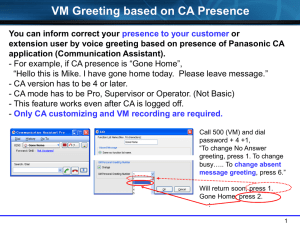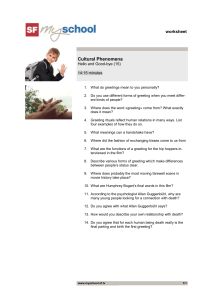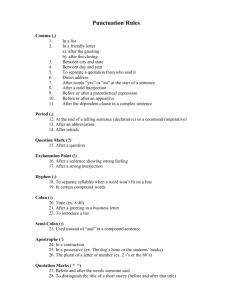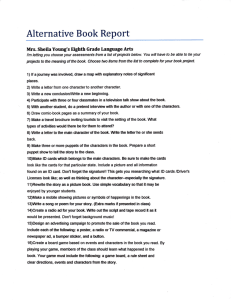Lecture 1 - Introduction
advertisement
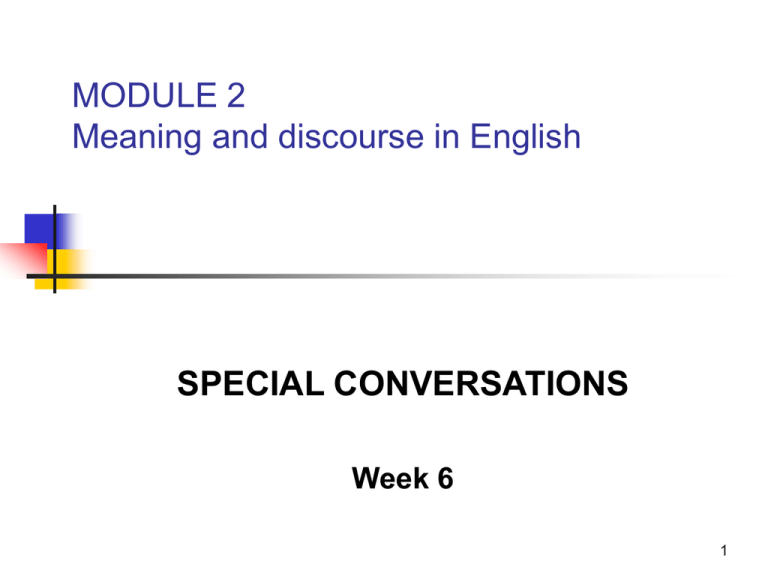
MODULE 2 Meaning and discourse in English SPECIAL CONVERSATIONS Week 6 1 Types of special conversation Ordinary conversation is general chat between friends and acquaintances. Other conversations take place in special circumstances, such as: Service encounters Institutional talk (legal, medical, classroom) 2 The cafè (week 3) The conversation between Elizabeth and the Assistant is a service encounter which has its own particular discourse patterns 3 SERVICE ENCOUNTERS obligatory elements An offer of service A request for service A transaction A salutation 4 Teacher and student T. Gemma do you think..? G. yeah T. go on / mmmm / okay G. you don’t have to be … T. no G. it’s the way … Initiation (question) Response (answer) Feedback (evaluation; reformulation; evaluation) Initiation Response (agreement) Continuation a good teacher will facilitate the conversation 5 LEARNING ENCOUNTERS The teacher takes most turns The teacher’s turns are longer than the students’ Students’ answers are short and elliptical 3 part structure (initiation-response-feedback) Teacher uses discourse markers to signpost the structure Teacher reformulates, summarise and evaluates students talk Teacher uses “ “display” questions (questions to which he/she knows the answer 6 Magistrate and defendant M. are you going to make an offer …? D. would you in my position M. I’m not here to answer questions - you answer my question ……………………………. M. are you prepared to make an offer to the court D. what sort of minimal offer M. it’s not a bargaining situation .. can I have the answer Question 1 Question 1 Imperative - repeating question 1 Question 1 Question 2 Question 3 - repeating question 1 This is an unusual structure ! 7 ASYMETRICAL TALK Asymetrical occurs when there are different power relations between speakers Typical asymetrical contexts are courtrooms, medical consultations, school classrooms “One rule for one and one rule for the other” is typical of asymetrical talk Dominant party usually has the right to ask questions while subordinate party has restricted right Questions require answers and also certain types of answer 8 TELEPHONE OPENINGS Summons-answer sequence Identification/recognition sequence Greeting sequence How-are-you? sequence These sequences apply to openings of calls between friends. How do they change when we are telephoning a shop, business or or institution? 9 Carla and Ida phone rings I: Hello C: Hello, Ida? I: Yeah C: Hi, this is Carla I: Hi Carla C: How are you? I: OK Summons Answer Request for receiver ID Receiver ID confirmed Greeting, caller ID confirmed Greeting How are you? Response 10 Beth and Ann phone rings B: Hello A: Hello B: oh hello Ann what’s up? A: nothing much just had something to ask you Summons Answer Greeting? Offer of ID? B recognises caller ID. Asks for subject of call Reply 11 English to English service call phone rings R: good afternoon. Edinburgh bookshop A: hello there .h ehm i’m looking for the book of the story of Pinocchio Summons Answer. Greeting. Workplace ID Greeting. Request The sequencing is much more compact in the opening of a service telephone call. Why? 12 Italian to Italian service call phone rings R: il libro fa per te buongiorno A: buongiorno mscusi vendete litesti universitari Summons Workplace ID. Greeting Greeting. Request How is this Italian-Italian call different from the English-English call? 13 Italian to English service call Summons phone rings R: good afternoon. Answer. Greeting. Blackwells may I Workplace ID. Offer of help. help you? Greeting. Request A: hh mh hi .hI was wondering i’m looking for a book by: primo levi Why does the caller hesitate before making his request? 14 Intercultural difficulties An intercultural communication problem is often caused by pragmatic difficulty The problem for the Italian caller is not that he does not understand the speaker but because he is not expecting the offer of help, which is rarely used in his language. So he does not know whether to respond to the offer (by saying “yes”) or by making his request. This is a pragmatic problem (i.e. when the conventions of one language are different from another) 15
